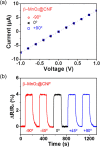Freestanding and Flexible β-MnO2@Carbon Sheet for Application as a Highly Sensitive Dimethyl Methylphosphonate Sensor
- PMID: 33644606
- PMCID: PMC7905932
- DOI: 10.1021/acsomega.0c06035
Freestanding and Flexible β-MnO2@Carbon Sheet for Application as a Highly Sensitive Dimethyl Methylphosphonate Sensor
Abstract
Research on wearable sensor systems is mostly conducted on freestanding polymer substrates such as poly(dimethylsiloxane) and poly(ethylene terephthalate). However, the use of these polymers as substrates requires the introduction of transducer materials on their surface, which causes many problems related to the contact with the transducer components. In this study, we propose a freestanding flexible sensor electrode based on a β-MnO2-decorated carbon nanofiber sheet (β-MnO2@CNF) to detect dimethyl methylphosphonate (DMMP) as a nerve agent simulant. To introduce MnO2 on the surface of the substrate, polypyrrole coated on poly(acrylonitrile) (PPy@PAN) was reacted with a MnO2 precursor. Then, phase transfer of PPy@PAN and MnO2 to carbon and β-MnO2, respectively, was induced by heat treatment. The β-MnO2@CNF sheet electrode showed excellent sensitivity toward the target analyte DMMP (down to 0.1 ppb), as well as high selectivity, reversibility, and stability.
© 2021 The Authors. Published by American Chemical Society.
Conflict of interest statement
The authors declare no competing financial interest.
Figures







References
-
- Gong H.; Xu Z.; Yang Y.; Xu Q.; Li X.; Cheng X.; Huang Y.; Zhang F.; Zhao J.; Li S.; Liu X.; Huang Q.; Guo W. Transparent, Stretchable and Degradable Protein Electronic Skin for Biomechanical Energy Scavenging and Wireless Sensing. Biosens. Bioelectron. 2020, 169, 11256710.1016/j.bios.2020.112567. - DOI - PubMed
-
- Bi L.; Yang Z.; Chen L.; Wu Z.; Ye C. Compressible AgNWs/Ti3C2Tx MXene Aerogel-Based Highly Sensitive Piezoresistive Pressure Sensor as Versatile Electronic Skins. J. Mater. Chem. A 2020, 8, 20030–20036. 10.1039/D0TA07044K. - DOI
-
- Chen L.; Yu H.; Dirican M.; Fang D.; Tian Y.; Yan C.; Xie J.; Jia D.; Liu H.; Wang J.; Tang F.; Zhang X.; Tao J. Highly Transparent and Colorless Nanocellulose/Polyimide Substrates with Enhanced Thermal and Mechanical Properties for Flexible OLED Displays. Adv. Mater. Interfaces 2020, 7, 200092810.1002/admi.202000928. - DOI
LinkOut - more resources
Full Text Sources
Other Literature Sources

